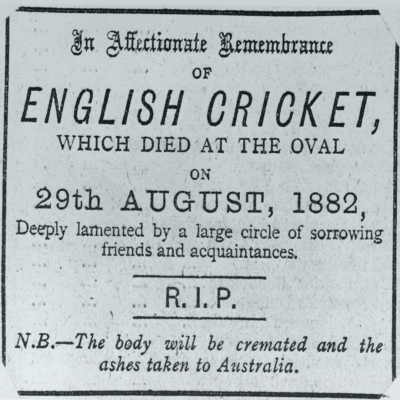In this article, we will go into the Ashes series history and see how the Ashes got its name. We will also see how the mini Ashes trophy, the Urn, first came into the picture. And lastly, we will let some numbers tell the Ashes story.
The Ashes Memories
The Ashes – the two words bring up a lot of memories for people, to each his own. For some, it reminds them of the infamous Bodyline series in 1932-33 to stop the great Don Bradman from scoring. Some remember the Ashes series for Jim Laker’s 10-wicket haul while others remember it for Shane Warne’s ‘the ball of the century’ in 1993 to castle Mike Gatting. In fact, except the cold umpire, everyone on the ground was absolutely stunned! Now, who can forget such moments? Also, the moment when Andrew Flintoff went down to have a word with a disconsolate Brett Lee after Australia lost a thriller at Edgbaston in 2005, was a sight for the ages.
Mitchell Johnson’s bouncers at the WACA, Stuart Broad’s manic spell of 8 for 15 to have Australia bowled out for just 60, and Jofra Archer knocking over Steve Smith in a fiery spell of fast bowling at Lord’s in 2019. All these moments exemplify the intensity of the Ashes.
The Ashes Series History
The Ashes has always been special and intense series, despite the one-sided nature of the series in recent times. So what is it about the series that makes the world take notice? Let’s dive deep into the Ashes history.
The embarrassing defeat of the English Team in 1882
The England-Australia cricket rivalry dates back to 1877 when they played the first-ever Test in Melbourne, which saw Australia win by 45 runs, thanks to a brilliant century (165 runs in the 1st innings) from Australia’s opening batsman Charles Bannerman.
In 1882, Australia toured England for a one-off Test, the ninth time that the two sides had met for such a battle.
The tourists were bundled out for 63 in the 1st innings, at The Oval, but still went on to defend a target of just 85 runs in the final innings of the Test. Australia won that Test by 7 runs. That was the first time that they had defeated England on the English soil. It was ‘The Demon Bowler’ Fred Spofforth who took 14 wickets in that game.
Ironic Criticism of the English Cricket
Such was the shock of the defeat that it sent the press into a frenzy with everyone going after England’s dismal performance.
The one that stung the hardest, came from an ironic obituary printed in The Sporting Times.
It read:
“In Affectionate Remembrance of English cricket, which died at the Oval on 29 August 1882.
“Deeply lamented by a large circle of sorrowing friends and acquaintances.
“R.I.P.
“N.B. – The body will be cremated and the ashes taken to Australia.”

This ironic obituary was the talk of all towns and eventually led to even more criticism of the English players.
The manner of ridicule hurt the English players. When the English captain Ivo Bligh (who later became Lord Darnley) embarked on the tour to Australia, he vowed to win back ‘the ashes’. And his opposite number, WL Murdoch echoed similar sentiments and promised to defend them.
And that was how the series got its name.
England regained the Ashes and also got the Urn
The side played three scheduled matches against Australia and won the series 2-1. It was a moment of great relief for the English players and the fans. It was considered that England have ‘won back the ashes’
During the visit, Ivo Bligh’s team also played a few social matches and after one such affair in Melbourne, just before Christmas, the captain was presented with a small, symbolic terracotta urn, which is also thought of to be a perfume bottle.
There is a label printed on it which contains a six-line poem published in The Melbourne Punch which begins with ‘When Ivo goes back with the urn, the urn’.
The mystery of what was in the Urn?
Many have speculated about the content of the urn. One story that is most common is that it contains the ashes of the bails, burned by the wife of one of the team’s hosts, during the tour. There were also other stories stating it contained the ashes of the stump or the outer casing of the ball, while Ivo Bligh’s daughter-in-law claimed it contained the remains of Florence Morphy’s veil. So many speculations. So much mystery!
The story of the burnt bails is however widely accepted. Whatever might be the true story, but the Urn and its significance to the England-Australia cricket rivalry, have given another dimension to the Ashes series.
The urn was gifted by a group of Melbourne women which also included Bligh’s future wife Florence Morphy. She was the companion to Lady Janet Clarke, mistress of Rupertswood, and governess to the Clarke children during the tour.
In February 1884, Bligh married Florence and returned to England, taking back the urn – something which remained a prized possession for him.
When did the Urn become the Ashes trophy?
The trophy handed to Bligh was never used as one for the Ashes though. It stayed on the mantlepiece at the Bligh family home – Cobham Hall, near Rochester in Kent – until Bligh died, 43 years later. At his request, Florence handed down the urn to MCC in 1927.
75 years on, it was in 1990, after the insistence of the two teams’ desire to compete for an actual trophy, MCC commissioned an urn-shaped Waterford Crystal Trophy.
This was first presented to Mark Taylor after his side won the 1998-99 series. Ever since then, the trophy has been handed to the winning captain at the end of each Test series between Australia and England.
From October 2006 to January 2007, the urn formed the centerpiece of the MCC Travelex Ashes Exhibition, which visited seven museums in six Australian states and attracted over 105,000 visitors. It remains the last time that the Urn left Lord’s.
Numbers Narrating The Ashes History
Let’s now look at the story of the Ashes through numbers which would tell us more about who’s won the Ashes more often and who’s done well for the two sides. (All numbers last updated on November 21, 2019)
Win-loss Records
33-32: Australia lead the Head-to-Head Ashes series battles in the 65 Ashes series contested till now.
England won the first eight Ashes series from 1882 to 1890 and had a win percentage of 56.25 till the end of World War II.
Australia’s series-winning ratio post it is 1.75 which speaks volumes about their dominance. They have won seven out of the 15 contested series’ with England winning just four.
The 5-0 Record
Only twice though has a side won an Ashes series 5-0: Australia beat England by this margin twice in recent times, in 2006/07 and 2013/14.
Player Records
Let’s look at some of the records held by players while contesting in the Ashes series.
Batting Records:
Most number of runs: Don Bradman (5028 runs)
Highest batting average: Don Bradman (89.78)
Most number of tons: Don Bradman (19 centuries)
Most runs in an Ashes series: Don Bradman with 974 runs in 1930.
Highest individual score: 364 by Len Hutton in 1938 at The Oval.
Bowling Records:
Most number of wickets by a bowler: Shane Warne (195)
Best figures in a bowling inning: Jim Laker (10/53)
Most wickets in an Ashes series: Jim Laker (46)
Other Records:
Allan Border has played the most number of Ashes Tests as captain: 28.
Team Records:
The highest score for a side: 903 for 7 declared by England in 1938
Highest margin of victory: An innings and 579 runs at The Oval. Australia were bowled out for 201 and 123 in response to England’s 903.
Lowest team total: 36 by Australia in Birmingham in 1902.
Lowest margin of victory: England beat Australia by two runs in 2005 at Edgbaston.
Most runs in a Test: 1753 in Adelaide in 1921
So those were some of the interesting stories and memories from the Ashes series history. We also saw the story of the urn and the mystery of its contents. And finally, the numbers gave a quick glimpse of the games played as part of the Ashes. Tell us some of your nostalgic memories from the Ashes, in the comments section below.
(About the Author: Nikhil is a passionate cricket writer who thrives on following the beautiful sport cricket and writes extensively on the same. Apart from that, he is a Potterhead till the end of time. He can be followed on Twitter @CricCrazyNIKS)
Sources:
You may like:


Leave a Reply